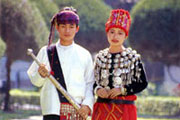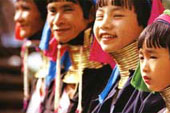Minority Tribes
MYANMAR HAS
MORE THAN 135 ETHNIC GROUPS THAT HAVE LONG BEEN LIVING
TOGETHER THROUGH THICK AND THIN. THE MYANMAR RACE CONSISTS
OF BAMAR, CHIN, KACHIN, KAYAH, KAYIN, MON, RAKHINE AND SHAN.
BAMAR, OUT OF THEM, REPRESENTS THE 70 PER CENT OF THE TOTAL
INHABITANTS OF THE COUNTRY.
 BAMAR BAMAR
It
is said by the 10th century Bamar tribe came to prominence.
Their language belonged to the same Tibeto-Burmese language
family as the Pyu, which have been described as the
proto-Burmese. It is still debatable whether they migrated
down the Ayayarwaddy valley from Yunan province or whether
they were the direct descendents of the fallen Pyu. These
people make their home throughout the Ayeyarwaddy delta and
majority are Buddhists. |
 CHIN CHIN
Chin
State, in the far west of Myanmar, is the traditional home
of Chin culture. Almost half a million people live in the
state's 10,206 square kilometers. Traditionally, Chin women
tattoo their faces and wear ornaments of bronze and copper.
Chin men historically have dressed in an almost western
style, with pants and shirts. Most of Chin state is closed
to foreigner traveler; some northern parts of the state,
however, are open with prior permission. Of interest to both
local and foreign travelers, is Mount Victoria, renowned for
its bird-watching. |
 KACHIN KACHIN
Kachin,
living in the extreme north of Myanmar is also known as Jing
Phaw. Bordering China to the east and India to the north Kachin state comprises 55,006 square kilometers. The
majority of the state's 1.4 million inhabitants are Kachins,
although the state is home to another 13 ethnic groups. Most
of the 1.2 million inhabitants live upland, where the
Malihka, Ayeyarwaddy, Tanainghka, and Mehka rivers form
green valleys. kachins are originally from the Tibeto-burman
tribe. They recognize the spirit world presided over by
Karai Kaseng as supreme deity. They periodically pay homage
to the Nats, with the ceremonies involving animal sacrifices
as a means of gaining favor with the spirits.
|
 KAYAH KAYAH
Kayah
state is one of the smallest in Myanmar - only a quarter of
a million people live in this eastern enclave of 7,248
square kilometers. Kayah's beautiful mountains house
numerous tribes: at last count, at least eight ethnic groups
living in the state. Among them are the Taungthu, Padaung,
Yinbaw, Bre and the majority Kayah. The Kayahs are a mix of
animists, Christians and Buddhists. The region's most famous
religious festival is the Kuhtobo in May, which celebrates
the rain spirits.
|
 KAYIN KAYIN
Kayin
State, located in the southeast of the country on the Thai
border, is the home of 1.6 million people, among them around
one million of residents are ethnic Kayin. They are the
third largest tribal groups in the country. Total area is
18,770 square kilometers and much of the north and east of
the state are off-limits to foreign travelers. There are
many Christians and Buddhist among the Kayin people. |
 MON MON
Mon
people lives in the southern part of the country. They are
believed to have entered into Myanmar earlier than Bamar
race. They are Mon-Khmar origin and their native land was
once called Ramanya. Their unique culture dramatically
influence on Myanmar language, literature and music. |
 SHAN SHAN
Shan
State, the largest of any of Myanmar's states and divisions,
occupying almost a quarter of Myanmar's total land mass -
96,248 square kilometers - lies in the east of the country
bordering with China, Laos and Thailand. The state's five
million inhabitants come from a variety of ethnic groups.
Although the majority people of the state are Shan ethnic,
the Palaung, Kachin, Kaw, Lahu, Kokang, Wa, Padaung and
Taungthu are also numerous. The state is open to the
influence of Thailand and their language are quite similar
to Thai. Most of the ethnic embraces Buddhism and the state
was once divided into 32 territories and ruled by the
hereditary chieftains known as Sao-bwas. The best known
destination in the state is Inle Lake, a breathtakingly calm
body of water ringed by hills and known as Venice of the
east. |
OTHERS
Kayaw Tribe: A tribe from the distant part of the Kayah state,
the Kayaw are rarely encountered by outsiders, be they local
or tourists. Interestingly, when a Kayaw man reaches the age
of forty, it is traditional that he fells a tree and builds
his own coffin. After death, he is sealed in the coffin
which is either hung from a cliff or placed in a cave as
final resting place.
Moken: The Moken people,
often called simply 'sea gypsies', are a race of their own,
having lived on sea in their primitive craft for generation
after generation. Found mostly in Tanintharyi division, they
survive by fishing and diving for pearl, trading their catch
for other foods, clothing and fuel. |
 Naga
Tribe: Living in the northwest part of the
country, Naga was once known as head-hunters. They still
preserve their traditional customs and beliefs while living
on hunting and crops they have cultivated. Naga's festival
held around January is getting more and more prominent
amongst foreign travelers. Naga
Tribe: Living in the northwest part of the
country, Naga was once known as head-hunters. They still
preserve their traditional customs and beliefs while living
on hunting and crops they have cultivated. Naga's festival
held around January is getting more and more prominent
amongst foreign travelers.
|
 Padaung Tribe: When
Padaung girls reach the age of eight or nine years, they are
fitted with a brass neck ring. Their culture demands that
each year another ring is added, both to their necks and
later their legs and arms as they grow older. Most of the
Padaung live near Loikaw, the capital of Kayah state. Padaung Tribe: When
Padaung girls reach the age of eight or nine years, they are
fitted with a brass neck ring. Their culture demands that
each year another ring is added, both to their necks and
later their legs and arms as they grow older. Most of the
Padaung live near Loikaw, the capital of Kayah state.
Thet Tribe: Living in
Rakhine state, the Thet are one of the oldest and smallest
tribal groups from the age of Pyu. They are known by foreign
scholars as Sakkya tribe and famous for their large earrings
made of silver and bamboo.
|